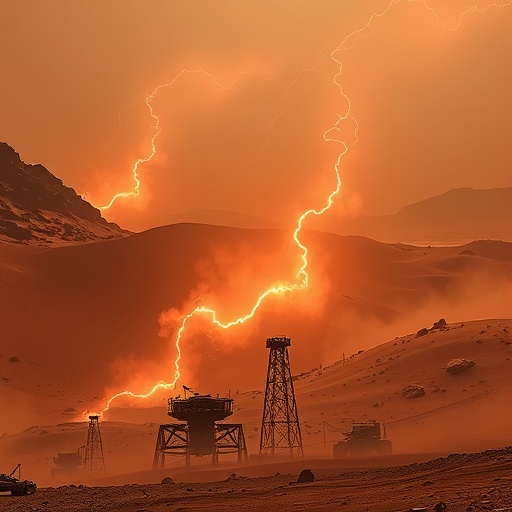In a groundbreaking advancement for planetary science, researchers have, for the first time, directly detected electrical discharges on Mars, confirming a long-standing hypothesis about atmospheric electrification on the Red Planet. This discovery, made by instruments aboard NASA’s Perseverance rover, provides concrete evidence that Mars, much like Earth and other gas giants such as Jupiter and Saturn, experiences energetic electrical phenomena linked to its characteristic dust storms and dust devils.
Electrical activity in planetary atmospheres has been well-documented on Earth, where lightning and electrical discharges occur frequently during thunderstorms and dust storms. Similar phenomena have been extensively observed on gas giants, including intense lightning observed in Saturn’s and Jupiter’s turbulent atmospheres. However, despite the dusty, dynamic nature of Martian weather, direct detection of electrical discharges on Mars had remained elusive—until now.
Mars presents a unique challenge compared to other planets due to its thin atmosphere and frequent dust events that cover vast regions, from small dust devils rising meter-scale vertically to planet-encircling dust storms that can spread over thousands of kilometers. Scientists have speculated for decades that the physical processes driving these dusty atmospheres—primarily triboelectric charging, where particles acquire static charge through friction—would naturally lead to large electrical fields, potentially culminating in intermittent lightning-like discharges.
Historically, charged dust phenomena have been observed in Earth’s arid deserts, where aeolian (wind-driven) processes generate measurable electric fields within dust storms and dust devils. These terrestrial analogues have been a critical reference point for predicting similar processes on Mars. Yet, until the recent Mars missions furnished sufficiently sensitive instrumentation, no direct electrical measurements had confirmed such activity in the Martian environment.
The pivotal breakthrough comes thanks to the SuperCam instrument suite on the Perseverance rover, notably its high-fidelity microphone capable of capturing acoustic signatures previously inaccessible in such detail from the Martian surface. Over the course of two Martian years, scientists recorded fifty-five distinct electrical discharge events coinciding with dust activity, ranging from small-scale dust devils to the convective fronts of dust storms advancing across the landscape.
Analysis of these signals reveals that Martian electric fields can indeed reach or exceed the atmospheric breakdown threshold—estimated at tens of thousands of volts per meter—enabling discharges comparable in nature to terrestrial lightning, though occurring in the vastly different conditions of Mars’s low-pressure atmosphere. These in situ observations provide unambiguous proof that triboelectric discharges, the result of charged dust particle collisions and interactions, are an active process shaping the Martian near-surface environment.
The implications of electrical activity on Mars extend far beyond simple meteorological intrigue. Electrification can fundamentally influence the behavior of dust and sand transport, affecting the dynamics of dust storms by promoting particle aggregation or altering aerodynamic properties. This, in turn, modifies the climatic and weather patterns on Mars, with potential feedbacks on atmospheric chemistry and surface conditions.
Perhaps most importantly, the presence of electrical discharges impacts the highly reactive chemistry of the Martian atmosphere. Electrical phenomena drive electrochemical reactions that can enhance the oxidizing power of the surface and near-surface environments. This oxidative chemistry is crucial to understanding the degradation or preservation of organic molecules on Mars—key considerations for astrobiology and the assessment of past or present habitability.
By facilitating the breakdown of chemical bonds through high-energy processes, triboelectric discharges could either hinder or promote the detection of biosignatures by modifying organic molecules before they can be sampled or analyzed by robotics. Thus, this new data recalibrates how scientists interpret findings from Mars missions aimed at uncovering signs of life or prebiotic chemistry.
Furthermore, the discovery holds practical significance for future human exploration and long-term habitation of Mars. Electrical events of this nature could impose risks on surface operations by influencing dust adhesion to equipment, interfering with electronics, or posing hazards arising from unexpected electrostatic discharges during dust storms. Understanding and mitigating these risks will be essential in designing robust infrastructure for astronauts.
This milestone also provides new opportunities for exploring Martian weather dynamics and improving atmospheric models. By integrating the electrical parameters observed into global circulation models, researchers can better simulate dust storm evolution, predict atmospheric electrical activity, and refine predictions of environmental conditions for upcoming missions.
In addition, the methodology combining electric and acoustic sensors aboard Perseverance opens a novel frontier in planetary meteorology. The ability to detect subtle electrical signals coupled with infrasound allows scientists to distinguish between different types of aeolian events, enhancing the granularity of environmental monitoring on the Martian surface.
With these findings, the longstanding question of whether Mars experiences electrically active weather phenomena has been conclusively answered. The detection of triboelectric discharges not only validates decades of theoretical work but also deepens our understanding of Mars as an active planet with complex atmospheric processes that parallel, yet differ fundamentally from, those on Earth.
Looking ahead, this discovery invites renewed investigation into how electrical processes interact with other Martian phenomena such as dust lifting, atmospheric chemistry, radiation exposure, and potential biological processes. It underscores the need for future missions to carry enhanced electric field and acoustic sensing payloads to further dissect these interactions in greater spatial and temporal detail.
Ultimately, the revelation that Mars hosts its own brand of sparks and discharges heralds a new chapter in planetary science—one where the Red Planet emerges as an electrically vibrant world, reshaping our conception of its environment, habitability, and the challenges awaiting explorers who dare to tread its dusty surface.
Subject of Research: Detection of triboelectric discharges in the Martian atmosphere during dust events using in situ instrumentation aboard the Perseverance rover.
Article Title: Detection of triboelectric discharges during dust events on Mars
Article References:
Chide, B., Lorenz, R.D., Montmessin, F. et al. Detection of triboelectric discharges during dust events on Mars. Nature 647, 865–869 (2025). https://doi.org/10.1038/s41586-025-09736-y
DOI: 10.1038/s41586-025-09736-y (Published 27 November 2025)




